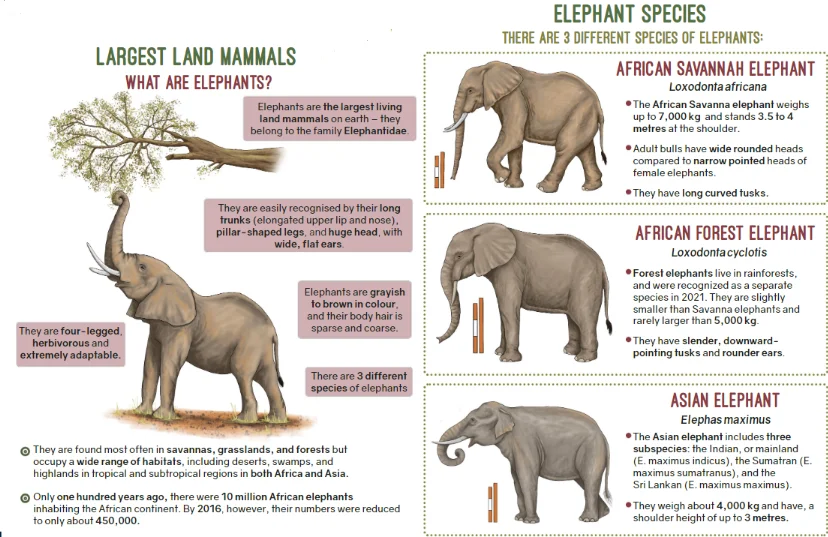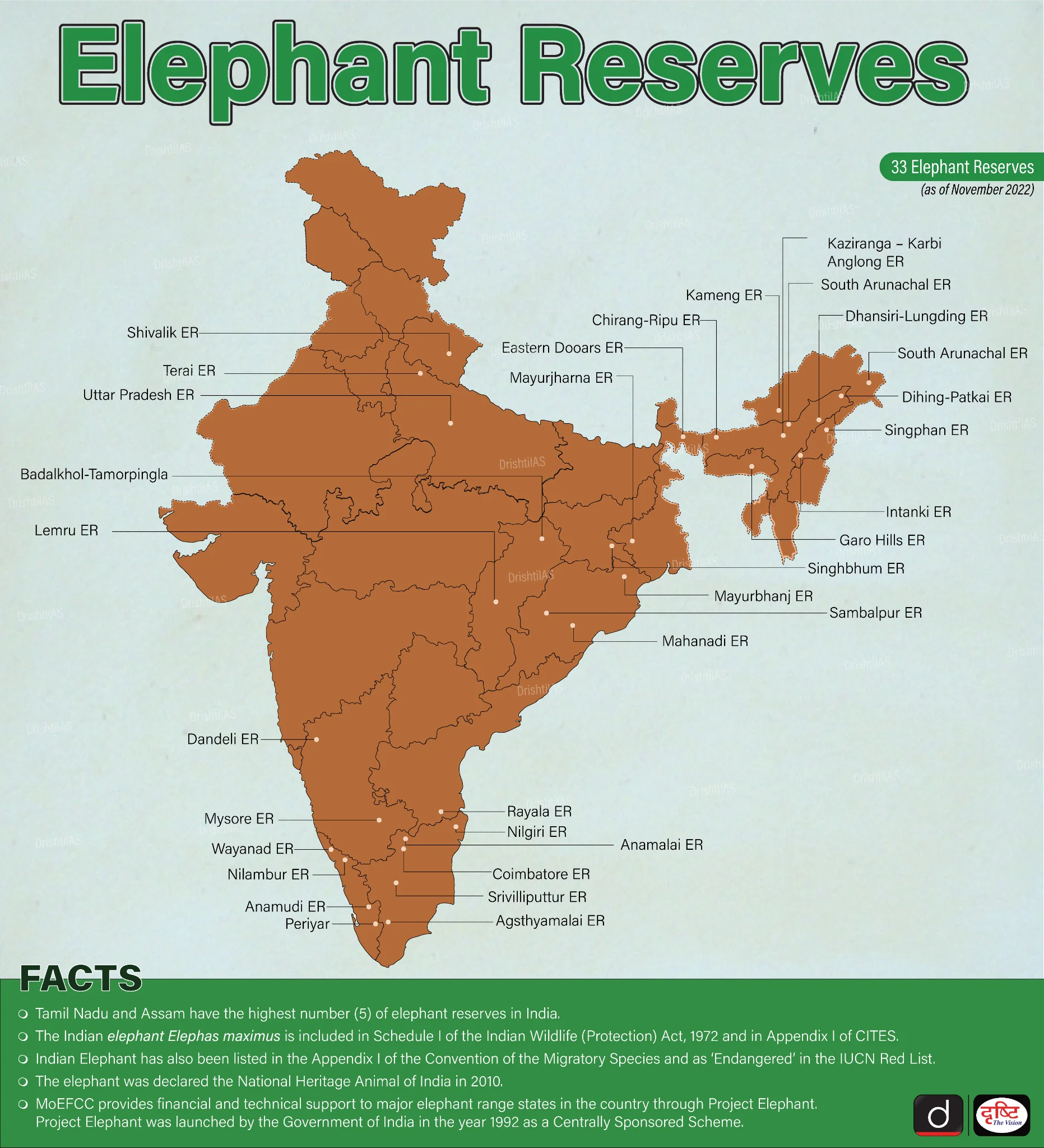Biodiversity & Environment
Elephant Conservation in India
- 12 Aug 2025
- 12 min read
For Prelims: Asian elephants, IUCN Red List, Project Elephant , Monitoring the Illegal Killing of Elephants (MIKE) programme
For Mains: Human–elephant conflict: causes, impacts, and mitigation strategies, Human-Animal Conflict, Issues of Human-Wildlife Conflict and Solutions.
Why in News?
On 12th August, the Ministry of Environment, Forest and Climate Change (MoEF&CC) celebrated World Elephant Day in Coimbatore, focusing on human-elephant conflict.
World Elephant Day
- Patricia Sims of Canada and the Elephant Reintroduction Foundation of Thailand, jointly established World Elephant Day on 12th August 2012. Since then Patricia Sims continues to lead the initiative.
- The initiative, partnered with over 100 organisations, aims to raise global awareness on elephant conservation, with millions showing support each year through World Elephant Day.
Key Facts About Elephant
- Three species: There are three different species of elephant: the African Savannah elephant, the African Forest elephant and the Asian elephant.
- African elephants have larger ears shaped like Africa, Asian elephants’ ears resemble the Indian subcontinent. African elephants have two trunk “fingers”, Asians have one.
- World’s Largest Land Animal: The African Savanna (Bush) elephant is the world's largest land animal.
- Elephant Lifespan and Reproduction: Elephants can live up to 65 years. Females reach puberty at 11, have a 22-month pregnancy, and stay fertile into their late 40s. Under ideal conditions, populations can grow by 7% annually.
- Social Structure: A matriarch, usually the oldest and most respected female, leads the family.
- Tusks: Enlarged incisor teeth that grow for life. It is used for feeding, digging, and defense; targeted for ivory, making elephants vulnerable to poaching.
- Communication: Use sound, body language, touch, scent, and seismic vibrations detected through bones.
- Population Decline: 90% of African elephants lost in the past century. Asian elephant populations are down by at least 50%. Habitat loss disrupts migration routes and increases human-elephant conflict.
How India is Ensuring the Conservation of Elephants?
- Elephants in India: India hosts over 60% of the world’s wild Asian elephants (Elephas maximus), specifically the Indian elephant subspecies (Elephas maximus indicus).
- As the country’s National Heritage Animal, they play a crucial role as ecosystem engineers, aiding in seed dispersal, nutrient cycling, and climate regulation.
- As keystone (ecosystem shapers), umbrella (protecting coexisting species), and flagship species (symbols of conservation), Elephants sustain tropical forests and perennial rivers.
- Status of Asian Elephants in India: The Asian elephant, India’s largest terrestrial mammal, is found mainly in the south, northeast, and central regions.
- About 28,000–30,000 live in fragmented populations across four regions, making habitat and corridor conservation crucial.
- Protection Status of Asian Elephants: IUCN Red List (Endangered), Wildlife (Protection) Act, 1972 (Schedule I), and Convention on International Trade in Endangered Species of Wild Fauna and Flora (CITES) (Appendix I).
- Project Elephant: It is a centrally sponsored scheme, launched in 1992 under MoEFCC, Project Elephant supports 22 states/UTs in conserving elephants, their habitats, and migration corridors.
- It focuses on protection, conflict mitigation, and captive elephant welfare through funding, infrastructure, and anti-poaching measures.
- The Project Tiger and Project Elephant Scheme has been merged from FY 2023-24 and is now known as Project Tiger & Elephant.
- Project RE-HAB (Reducing Elephant-Human Attacks using Bees): It is an initiative by the Khadi and Village Industries Commission (KVIC) to mitigate human-elephant conflict using "bee-fences".
- It involves strategically placing bee boxes along elephant paths to deter them from entering human habitations, thus reducing both human and elephant fatalities.
- Achievements in Elephant Conservation: The wild elephant population in India has increased from 27,669-27,719 in 2007 to 29,964 in 2017, reflecting the success of conservation efforts.
- India has designated 33 Elephant Reserves across 14 states, providing critical habitats for elephants.
- These Elephant Reserves overlap with Tiger Reserves, Wildlife Sanctuaries and Reserved Forests which are protected under Wild Life (Protection) Act, 1972, Indian Forest Act, 1927 and other local State Acts.
- The MoEFCC and state forest departments have ground-validated 150 elephant corridors across 15 states, ensuring safe movement for elephants between fragmented habitats.
- Project Elephant has also started using geospatial tools such as Land Use Land Cover (LULC) analysis and satellite data to monitor changes in elephant habitats and identify potential threats.
- Monitoring and Future Directions: The CITES-led Monitoring the Illegal Killing of Elephants (MIKE) programme monitors illegal elephant killings to guide conservation action, while Wildlife Institute of India Elephant Cell supports conservation through technical expertise, capacity building, and frontline staff training.
What are the Challenges in Elephant Conservation?
- Elephant- Train Collisions: According to a recent MoEF&CC survey, between 2009- 2024, 186 elephants died in train collisions across India, mostly in Assam, West Bengal, Odisha, Kerala, and Uttarakhand.
- Causes include railway tracks through elephant corridors, poor visibility, high train speeds, and lack of timely alerts. These areas also threaten other wildlife like gaurs, deer, and leopards.
- Habitat Loss and Fragmentation: Expanding settlements and infrastructure projects shrink and break forests into small patches.
- Identified elephant corridors in India which are essential for seasonal movement and genetic exchange, are under heavy human pressure and risk being completely blocked in some areas.
- Rising Human–Elephant Conflict: Shrinking habitats push elephants into crop fields and villages, causing major damage to livelihoods.
- This leads to 400–500 human deaths annually and over 60 elephant deaths, mostly from retaliation.
- Climate change affects elephants by disrupting habitats, water, and food sources, worsening human-elephant conflict.
- Extreme weather events like droughts and floods force elephants into human-populated areas.
- Poaching for Ivory and Other Body Parts: Targeted killing of tusked males for ivory has skewed sex ratios in many populations.
- Poaching for meat, skin, and tail hair is still prevalent, particularly in Northeast India, despite the 1989 CITES ivory trade ban.
- Infrastructure-Related Threats: Low-hanging power lines causing electrocution, and injuries from crude bombs meant for other animals pose serious risks.
- Accidental Deaths: Elephants often fall into open wells, trenches, and pits, especially in human-modified landscapes, leading to fatal injuries.
- Limited Resources for Conservation: Many elephant habitats are in remote areas with poor monitoring and patrolling infrastructure.
- For instance, Odisha’s Similipal has limited forest staff and poor access roads, leading to weak management and a higher risk of poaching and conflict.
What are Measures Needed for Elephant Conservation?
- Mitigation of Elephant- Train Collision: MoEF&CC suggested mitigation measures such as building ramps, underpasses, overpasses, and installing Intrusion Detection Systems (IDS) to monitor and alert train operators about elephant movements.
- Chili Powder Fences and Beehives: Surrounding crops with fences coated in a mixture of chili powder and waste engine oil serves as a strong deterrent to crop-raiding elephants, thereby reducing human-animal conflict.
- Installing beehives along farm boundaries deters elephants, as they avoid bees; also provides farmers with honey income.
- Banana Trap Crops: Planting fodder crops like banana and napier grass along forest edges to divert elephants from main crops.
- Strengthen Habitat Protection: Reconnect fragmented habitats through land acquisition, Gram Sabha-led consent, and voluntary relocation, as recommended by the Elephant Task Force (2010).
- Technological Interventions: Using GPS Collar Tracking monitor elephant movement in real-time for conflict prevention. Predict migration routes and hotspots for human-elephant conflict.
- Capacity building: Strengthen forest staff in remote areas with better equipment, veterinary units, and non-lethal conflict training.
- Community Participation and Empowerment: Expand programs like Gaj Yatra program and Gaj Shilpi initiative involving people to raise awareness about elephant conservation.
|
Drishti Mains Question: Asian elephants in India are considered keystone species. Analyze the challenges faced in their conservation and suggest strategies for their long-term survival. |
UPSC Civil Services Examination, Previous Year Questions (PYQs)
Prelims
Q. With reference to Indian elephants, consider the following statements: (2020)
- The leader of an elephant group is a female.
- The maximum gestation period can be 22 months.
- An elephant can normally go on calving till the age of 40 years only.
- Among the States in India, the highest elephant population is in Kerala.
Which of the statements given above is/are correct?
(a) 1 and 2 only
(b) 2 and 4 only
(c) 3 only
(d) 1, 3 and 4 only
Ans: (a)
Mains
Q. The incidences of human-wildlife conflict have increased in recent years leading to negative consequences for both humans and animals. In light of this, analyze the causes and effects of such conflicts. Also suggest solutions to better manage this issue. (2024)









